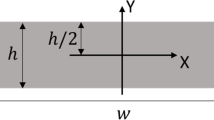Abstract
Very different patterns of geometry effects may occur if in a bend type specimen the ligament length is increased at constant specimen thickness. These geometry effects can be explained by a model of the total crack growth resistance R which is defined as the sum of the non-reversible energy which must be put into a body to produce an increment of crack area. The relationship between R and the commonly used J−Δa-curves is worked out. The model shows that a ‘wider-lower’ pattern, i.e. the case where an increase of the ligament length causes a flatter J−Δa-curve, appears for fracture under lefm conditions or for contained yielding where R is independent of the geometry. A ‘wider-no effect’ or a ‘wider-higher’ pattern may be observed if the crack extension occurs at the plastic limit load and if either plane strain or plane stress conditions prevail.
Similar content being viewed by others
References
C.E.Turner, in Fracture Behaviour and Design of Materials and Structures, Proceedings of ECF8, Vol. II, Engineering Materials Advisory Services Ltd., U.K. (1990) 933–968.
D.A.Davis, M.G.Vassilaros and J.P.Gudas, in ASTM STP 803, Vol. II (1983) 582–610.
S.J.Garwood, in ASTM STP 700, Vol. II (1980) 217–295.
O.Kolednik, Engineering Fracture Mechanics 38 (1991) 403–412.
C.E.Turner, in ASTM STP 1131, Vol. I (1992) 71–92.
J.R.Rice, P.C.Paris and J.G.Merkle, in ASTM STP 536, Vol. II (1973) 231–245.
ASTM E 813–82, Annual Book of ASTM Standards, Part 10.
C.E.Turner and O.Kolednik, in 25. Vortragsveranstaltung des DVM-Arbeitskreises Bruchvorgänge, DVM, Berlin (1993) 395–403 (in English).
C.E. Turner and O. Kolednik, Fatigue and Fracture of Engineering Materials and Structures, submitted.
ASTM E 1152–87, Annual Book of ASTM Standards, Vol. 03.01.
O.Kolednik, Steel Research 63 (1992) 315–317.
H.P.Stüwe, Engineering Fracture Mechanics 13 (1980) 231–236.
H.P.Stüwe, in Three-Dimensional Constitutive Relations and Ductile Fracture, S.Nemat-Nasser (ed.) North-Holland, Amsterdam (1981) 213–227.
O.Kolednik and H.P.Stüwe, Engineering Fracture Mechanics 24 (1986) 277–290.
O.Kolednik and H.P.Stüwe, International Journal of Fracture 33 (1987) R63-R66.
O.Kolednik and H.P.Stüwe, Zeitschrift für Metallkunde 73 (1982) 219–223.
S.J.John and C.E.Turner, in Defect, Assessment in Components-Fundamentals and Applications, ESIS/EGF 9, Mechanical Engineering Publications, London (1991) 299–318.
W.K.Wilson, Engineering Fracture Mechanics 2 (1970) 169–171.
G.X. Shan, O. Kolednik and F.D. Fischer to be published.
G.X.Shan, O.Kolednik and F.D.Fischer, Engineering Fracture Mechanics 45 (1993) 99–106.
C.E. Turner and L. Braga, in Proceedings of the Symposium on Constraint Effects in Fracture, Indianapolis (1991) 158–175.
Author information
Authors and Affiliations
Rights and permissions
About this article
Cite this article
Kolednik, O. A simple model to explain the geometry dependence of J−Δa-curves. Int J Fract 63, 263–274 (1993). https://doi.org/10.1007/BF00012472
Received:
Accepted:
Issue Date:
DOI: https://doi.org/10.1007/BF00012472




